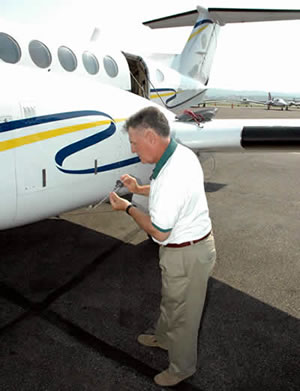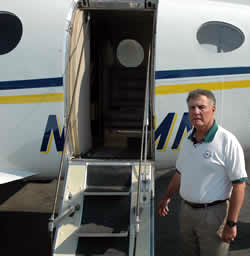By Nick Carpenter

Mn/DOT's chief pilot, Tim Valento, checks the oil level during a pre-flight inspection, a safety procedure conducted before every flight. Photo by Nick Carpenter |
Chief pilot Tim Valento is living out a childhood dream every day he’s in the air flying state employees to various destinations around the region.
As a young boy, Valento’s fascination with flying began after watching the planes land and take off at the St. Paul downtown airport. He also recalls daydreaming about flying when planes would rumble over his school.
“In high school, planes would always fly overhead,” Valento said. “I would always say to myself, ‘Someday I would like to do that.’”
Valento’s first pilot job was in Los Angeles, Calif. After years of various pilot jobs, he landed at Mn/DOT in March 1980. Valento worked as a pilot until 1992 when he was appointed Mn/DOT’s chief pilot.
Although the managerial duties of chief pilot (supervising three pilots and two support people) keep Valento from flying as much as he would like, he still manages to do what he loves a few days a week.
What do you like most about your job?
I like the variety. Every day is different from the next because we travel to different cities and meet different people.
The best part of my job is the great people who work for me. I don’t have to be here for stuff to get done because we have an excellent staff.
I also look forward to coming into work and flying the great equipment we have. Sure, there are tough days, but they’re primarily weather-related.
What’s your standard workday like?
On the days I have to fly, I’m up at 5 a.m. for a 7 a.m. flight. The first thing I do is go to my computer and check the weather. Then I’ll go over to the airport and pre-flight the plane.
During a pre-flight inspection we check the plane’s exterior, tires, propellers, fuel, oil and engines.
Then we check the weather again because we’re constantly checking the weather. After that, we wait for our passengers to arrive and we greet them.
From there we fly to our destination and call our dispatchers when we arrive. We are always trying to keep everybody informed about where we are.

Valento pauses near the entrance of the state’s Beech King Air 200, which holds up to eight passengers and can travel 200 mph. Photo by Nick Carpenter |
Who are your passengers?
My typical passengers are Mn/DOT employees. We also fly the governor and employees from other agencies, but about 70 percent of our passengers are from Mn/DOT.
Do you ever fly employees out-of-state?
Yes, I’ve been in almost every state. We get down to Chicago, Madison, North and South Dakota —you know, mostly in the five-state area.
We do get out further sometimes. When President Reagan died, we flew the governor to Washington, D.C., for the funeral.
What is the most challenging part of being a pilot?
I think it’s learning the weather. That is a really important part of flying.
A lot of the time inexperienced pilots might be a little over-zealous and think they can get somewhere without considering the conditions.
We are constantly checking the weather. If we think there are weather concerns we let our passengers know.
Has the responsibility of transporting passengers ever made you nervous?
No, I never feel nervous. We are all professional pilots who have been here a long time. We know our limits and our mission, which is to get you there safely.
I’m not going to do anything to jeopardize my safety. I want to retire someday.
Do you or a co-worker have an interesting job to share with readers? Click here to send us your ideas, and we’ll contact you for more information.
Recent profiles:
|



